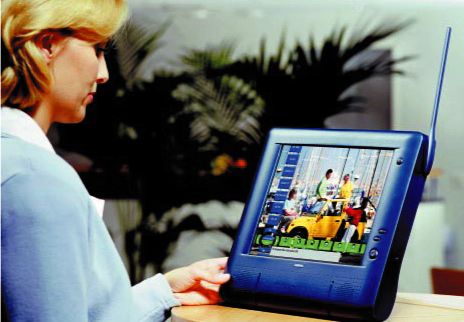| |
|
|
Passage
E
|
Digital
Television
|
|
 If
it takes a village to raise a child, who shapes the village?
Increasingly the answer is media,
especially TV. Despite all the talk about the power of the Internet,
TV is the most watched and most trusted source of information
for most Americans. 93 percent of Americans watch a network
television program in the course of a week, and 69 percent of
Americans say TV is the most trusted source of information.
No other source of information comes close. If
it takes a village to raise a child, who shapes the village?
Increasingly the answer is media,
especially TV. Despite all the talk about the power of the Internet,
TV is the most watched and most trusted source of information
for most Americans. 93 percent of Americans watch a network
television program in the course of a week, and 69 percent of
Americans say TV is the most trusted source of information.
No other source of information comes close.
Today's television system has served the American public well
for almost three generations.
Over the years, additional features and functions, such as color,
stereo sound, remote
control, cable channels, closed captioning,
and parental control
features were developed. However, today's television system
is now showing its age. A transition
to digital is occurring in all media technologies.
The arrival of digital television ("DTV") promises
to be one of the most significant
developments in television technology since the advent of color
television in the 1950's. DTV has the capability to provide
clearer and sharper, cinema-like pictures as well as multi-channel,
CD-quality sound. It can provide new uses such as multiple video
programs or other services on a single television channel, including
data services. The use
of DTV technology will also allow television to enter the digital
world of the personal computer and the Internet.
Then what is DTV? DTV is a new "over-the-air" digital
television system that will be used by the nearly 1600 local
broadcast television stations in the United States. The DTV
standard is based on the Advanced
Television System Committee (ATSC) standard A/53.
The DTV standard is a very flexible television system that
will allow broadcasters to provide new and higher quality services.
First, DTV will permit transmission of television programming
in new wide screen, high resolution
formats known as high
definition television (HDTV). In addition, the new DTV
television system allows transmissions in standard
definition television  (SDTV)
formats that provide picture resolution similar
to16 existing television service. Both the HDTV and SDTV
formats will have significantly better color rendition
than the existing analog
television system. The DTV system also will allow broadcasters
to transmit multiple programs simultaneously
using a single television channel. TV stations will, depending
on the type and source of programming, be able to transmit multiple
SDTV programs or in some cases two HDTV programs. DTV also will
provide improved audio quality, similar to that of compact
discs, with up to five channels of sound per program. (SDTV)
formats that provide picture resolution similar
to16 existing television service. Both the HDTV and SDTV
formats will have significantly better color rendition
than the existing analog
television system. The DTV system also will allow broadcasters
to transmit multiple programs simultaneously
using a single television channel. TV stations will, depending
on the type and source of programming, be able to transmit multiple
SDTV programs or in some cases two HDTV programs. DTV also will
provide improved audio quality, similar to that of compact
discs, with up to five channels of sound per program.
The new system will also support delivery of digital data services
simultaneously with television and audio
programming. Using this data transmission
capability, it will be possible for broadcast stations to send
publications (such as a local "electronic newspaper"),
program schedules, computer software, information requested
about specific products, or virtually
any other type of information, at the same time that they transmit
regular television programming. The DTV system also provides
the flexibility to support
the introduction of new services in the future, as technology
and viewer interests continue to develop.
|
|
|
|